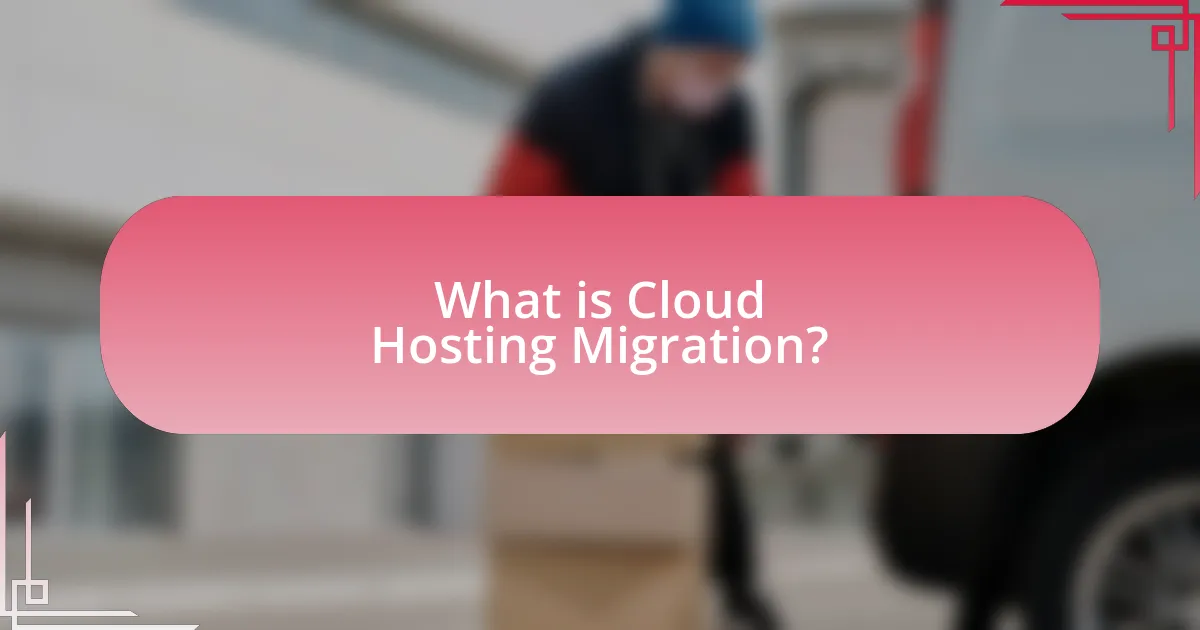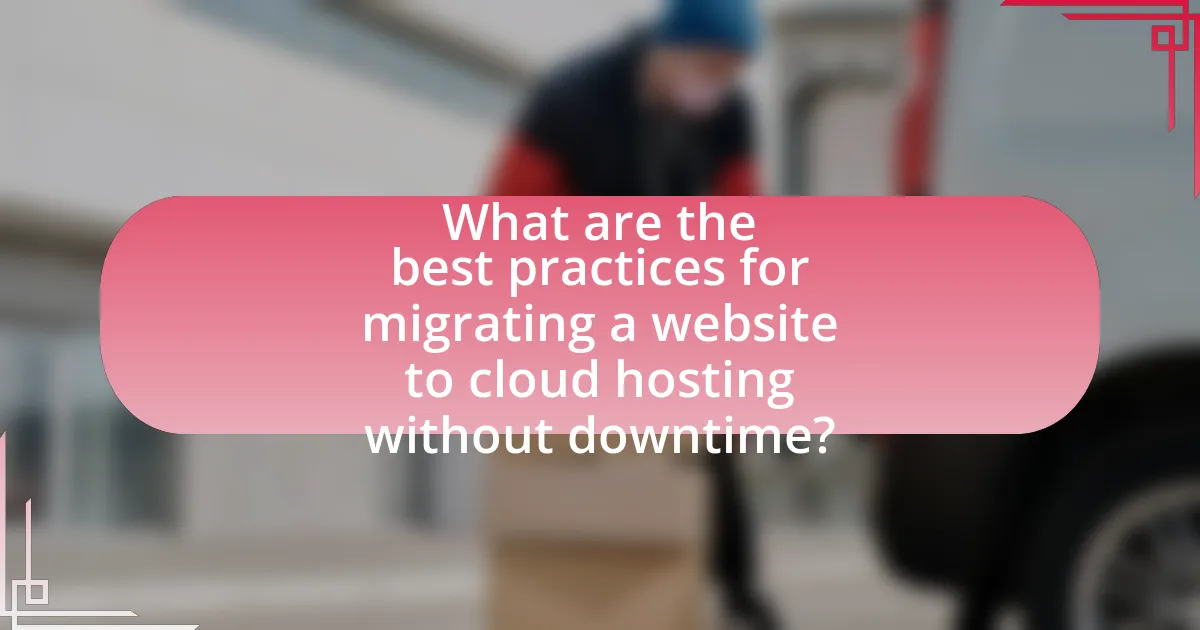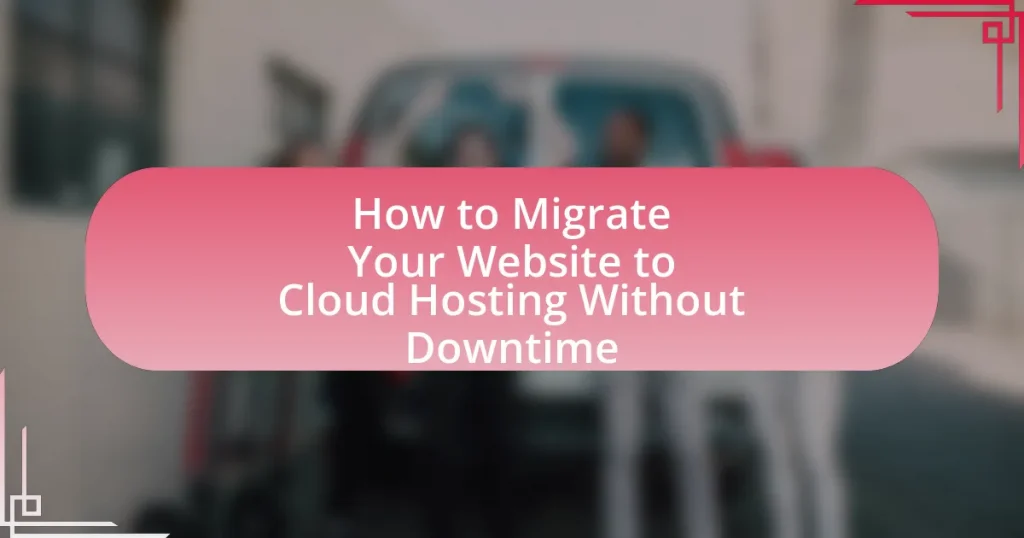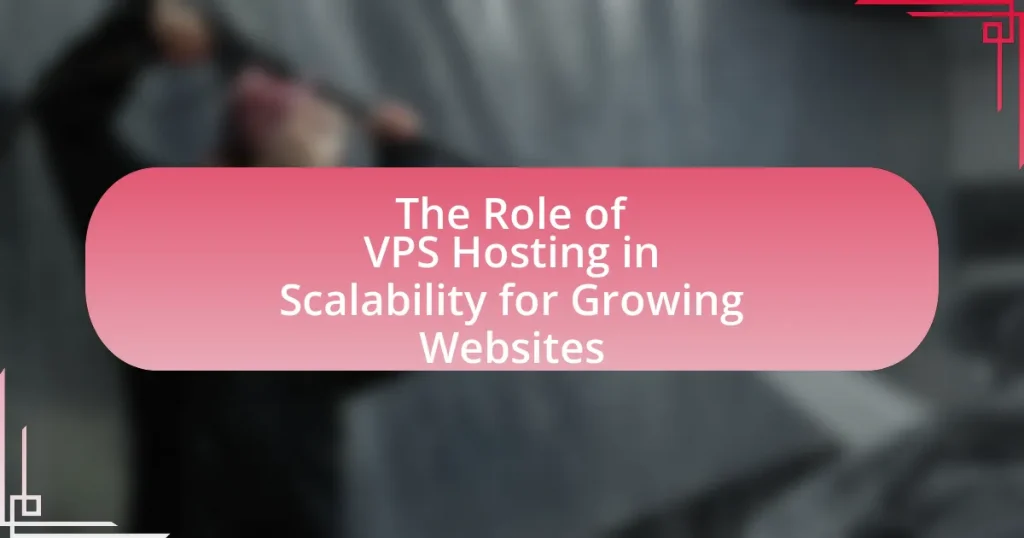Cloud hosting migration refers to the process of transferring a website or application from traditional hosting to a cloud-based infrastructure, offering benefits such as scalability, flexibility, and cost savings. The article outlines the key steps involved in this migration process, including assessment, planning, execution, and optimization, while emphasizing the importance of minimizing downtime. It also discusses the impact of different cloud hosting providers on the migration process, common challenges faced, and strategies to ensure a smooth transition. Additionally, best practices for post-migration monitoring and optimization are highlighted to maintain website performance and data integrity.

What is Cloud Hosting Migration?
Cloud hosting migration is the process of transferring a website or application from a traditional hosting environment to a cloud-based infrastructure. This transition allows for enhanced scalability, flexibility, and resource management, as cloud hosting utilizes a network of virtual servers to distribute workloads. According to a report by Gartner, organizations that migrate to cloud hosting can achieve up to 30% cost savings on IT infrastructure, demonstrating the financial and operational benefits of this migration strategy.
How does the process of migrating a website to cloud hosting work?
The process of migrating a website to cloud hosting involves several key steps: assessing the current website environment, selecting a suitable cloud hosting provider, preparing the website for migration, transferring the website data, and testing the website on the new cloud platform. First, website owners evaluate their existing infrastructure to determine requirements and compatibility with cloud services. Next, they choose a cloud provider based on factors such as performance, scalability, and support. After selecting a provider, they prepare the website by backing up data and ensuring that all components are ready for transfer. The actual migration occurs when files, databases, and applications are moved to the cloud server, often using tools or services provided by the cloud host. Finally, thorough testing is conducted to ensure that the website functions correctly in the new environment, confirming that all features and functionalities are intact. This structured approach minimizes downtime and ensures a smooth transition to cloud hosting.
What are the key steps involved in cloud hosting migration?
The key steps involved in cloud hosting migration include assessment, planning, execution, and optimization. First, assessment involves evaluating the current infrastructure, applications, and data to determine what needs to be migrated. Next, planning requires creating a detailed migration strategy, including timelines, resource allocation, and risk management. Execution follows, where the actual migration takes place, often using tools and services to facilitate the process while minimizing downtime. Finally, optimization involves monitoring the new cloud environment, making necessary adjustments, and ensuring performance meets expectations. These steps are critical for a successful migration, as they help mitigate risks and ensure a smooth transition to cloud hosting.
How do different cloud hosting providers impact the migration process?
Different cloud hosting providers significantly impact the migration process through their unique features, tools, and support services. For instance, providers like Amazon Web Services (AWS) offer extensive migration tools such as AWS Migration Hub, which simplifies tracking and managing the migration of applications. In contrast, Google Cloud Platform (GCP) provides the Transfer Service for Cloud, enabling efficient data transfer with minimal downtime. Additionally, the level of customer support varies; providers like Microsoft Azure offer dedicated migration assistance, which can expedite the process and reduce potential issues. These differences in tools, support, and features directly influence the ease, speed, and success of migrating to cloud hosting.
Why is migrating to cloud hosting important for businesses?
Migrating to cloud hosting is important for businesses because it enhances scalability, flexibility, and cost-efficiency. Cloud hosting allows businesses to easily adjust their resources based on demand, enabling them to scale up or down without significant capital investment. According to a report by Gartner, organizations can reduce IT costs by up to 30% by adopting cloud services, demonstrating the financial benefits of this migration. Additionally, cloud hosting improves accessibility, allowing employees to work remotely and collaborate in real-time, which is crucial in today’s digital landscape.
What advantages does cloud hosting offer over traditional hosting?
Cloud hosting offers scalability, flexibility, and cost-effectiveness over traditional hosting. Unlike traditional hosting, which typically relies on a single server, cloud hosting utilizes a network of servers, allowing resources to be allocated dynamically based on demand. This means that during peak traffic times, additional resources can be accessed seamlessly, ensuring optimal performance. Furthermore, cloud hosting often operates on a pay-as-you-go model, which can significantly reduce costs for businesses by only charging for the resources used. According to a report by Gartner, organizations can save up to 30% on IT costs by migrating to cloud solutions, highlighting the financial benefits of cloud hosting compared to traditional methods.
How can cloud hosting improve website performance and reliability?
Cloud hosting improves website performance and reliability by utilizing a network of interconnected servers that distribute resources efficiently. This architecture allows for load balancing, which ensures that traffic spikes do not overwhelm a single server, thus maintaining consistent performance. Additionally, cloud hosting offers automatic scaling, enabling websites to adjust resources in real-time based on demand, which enhances both speed and uptime. According to a study by Gartner, organizations that adopt cloud services can experience up to 30% faster load times and a 99.99% uptime guarantee, demonstrating the significant impact of cloud hosting on performance and reliability.

What are the common challenges faced during website migration?
Common challenges faced during website migration include data loss, downtime, SEO impact, and compatibility issues. Data loss can occur if backups are not properly managed, leading to missing content or functionality. Downtime is a significant concern, as it can affect user experience and revenue; studies show that even a few minutes of downtime can lead to substantial financial losses. SEO impact arises from changes in URLs or site structure, which can result in decreased search engine rankings if not handled correctly. Compatibility issues may arise with plugins, themes, or custom code that do not function as expected in the new environment, potentially disrupting website performance.
How can downtime affect a business during migration?
Downtime during migration can severely impact a business by causing loss of revenue, damaging customer trust, and hindering operational efficiency. When a website is unavailable, potential customers cannot access services or make purchases, leading to immediate financial losses. For instance, a study by Gartner indicates that downtime can cost businesses an average of $5,600 per minute, translating to significant losses over extended periods. Additionally, prolonged downtime can frustrate users, resulting in decreased customer loyalty and negative brand perception. This disruption can also affect internal operations, as employees may be unable to access necessary tools and data, further impeding productivity.
What are the potential risks of experiencing downtime during migration?
Experiencing downtime during migration poses significant risks, including loss of revenue, damage to brand reputation, and potential data loss. Revenue loss occurs because customers cannot access services or products during the downtime, which can lead to immediate financial impacts; for instance, a study by Gartner indicates that even an hour of downtime can cost businesses thousands of dollars, depending on their size and industry. Brand reputation suffers as users may perceive the business as unreliable, leading to decreased customer trust and loyalty. Additionally, data loss can occur if proper backup procedures are not followed, resulting in permanent loss of critical information. These risks highlight the importance of planning and executing migration strategies that minimize or eliminate downtime.
How can businesses prepare for potential downtime?
Businesses can prepare for potential downtime by implementing a comprehensive disaster recovery plan that includes regular backups, redundancy systems, and a clear communication strategy. Regular backups ensure that data can be restored quickly, while redundancy systems, such as load balancers and failover servers, minimize the impact of hardware failures. A clear communication strategy keeps stakeholders informed during downtime, which is crucial for maintaining trust. According to a study by the Ponemon Institute, the average cost of IT downtime is $5,600 per minute, highlighting the importance of proactive measures to mitigate financial losses and operational disruptions.
What strategies can be employed to minimize downtime during migration?
To minimize downtime during migration, implementing a phased migration strategy is essential. This approach involves transferring data and applications in stages rather than all at once, allowing for continuous operation of the existing system while new components are integrated. Additionally, utilizing load balancing can distribute traffic between the old and new systems, ensuring users experience minimal disruption.
Furthermore, conducting thorough pre-migration testing helps identify potential issues before the actual migration, reducing the likelihood of unexpected downtime. According to a study by the Cloud Industry Forum, organizations that employed phased migrations reported up to 70% less downtime compared to those that migrated all at once. These strategies collectively enhance the reliability of the migration process and ensure a smoother transition to cloud hosting.
How does a phased migration approach work?
A phased migration approach works by systematically transitioning a website to cloud hosting in stages rather than all at once. This method allows for testing and validation of each phase, minimizing risks and ensuring that any issues can be addressed before proceeding to the next stage. For example, an organization might first migrate non-critical components, assess performance and functionality, and then gradually move more critical elements, ensuring that the website remains operational throughout the process. This approach is supported by industry practices that emphasize risk management and continuity, making it a preferred strategy for maintaining uptime during migration.
What role does data synchronization play in reducing downtime?
Data synchronization plays a critical role in reducing downtime during cloud hosting migrations by ensuring that data is consistently updated across all systems in real-time. This process minimizes the risk of data loss and discrepancies, which can lead to service interruptions. For instance, when migrating a website, synchronized data allows for seamless transitions between the old and new hosting environments, enabling users to access the latest information without experiencing outages. Studies have shown that organizations implementing effective data synchronization strategies can reduce downtime by up to 50%, highlighting its importance in maintaining operational continuity during migrations.

What are the best practices for migrating a website to cloud hosting without downtime?
To migrate a website to cloud hosting without downtime, implement a phased migration strategy. This involves setting up the cloud environment parallel to the existing infrastructure, allowing for data synchronization and testing before the final switch.
First, create a replica of the website on the cloud server, ensuring that all configurations, databases, and files are accurately mirrored. Utilize tools like rsync for file synchronization and database replication techniques to keep data consistent.
Next, conduct thorough testing on the cloud environment to verify functionality and performance. Once confirmed, update the DNS settings to point to the new cloud server. To minimize downtime, use a low TTL (Time to Live) value for DNS records prior to migration, allowing for quicker propagation.
Finally, monitor the website closely after the switch to address any issues promptly. This approach is supported by industry practices that emphasize the importance of testing and gradual transitions to maintain service availability during migrations.
How can thorough planning facilitate a smooth migration?
Thorough planning facilitates a smooth migration by ensuring all aspects of the migration process are anticipated and addressed in advance. This includes identifying potential risks, establishing a clear timeline, and allocating resources effectively. For instance, a study by the Cloud Industry Forum found that organizations with a detailed migration plan experienced 30% fewer disruptions compared to those without one. Additionally, thorough planning allows for the testing of the new environment before the actual migration, which can identify issues that may arise, further minimizing downtime.
What elements should be included in a migration plan?
A migration plan should include the following elements: assessment of current infrastructure, selection of cloud service provider, data backup strategy, migration timeline, resource allocation, testing procedures, and a rollback plan.
The assessment of current infrastructure identifies existing systems and applications that need migration. Selecting a cloud service provider involves evaluating options based on performance, cost, and support. A data backup strategy ensures that all data is securely backed up before migration to prevent loss. The migration timeline outlines the schedule for each phase of the migration process. Resource allocation specifies the personnel and tools required for a successful migration. Testing procedures are essential to verify that applications function correctly in the new environment. Finally, a rollback plan provides a strategy to revert to the original setup in case of unforeseen issues during migration.
These elements are critical for ensuring a smooth transition to cloud hosting without downtime, as they address potential risks and establish a clear framework for the migration process.
How can testing before the migration help ensure success?
Testing before migration helps ensure success by identifying potential issues and compatibility problems in advance. This proactive approach allows teams to address vulnerabilities, ensuring that the migration process runs smoothly. For instance, a study by the Cloud Industry Forum found that 70% of organizations that conducted pre-migration testing reported fewer post-migration issues. By validating the functionality of applications and data integrity before the actual migration, organizations can minimize downtime and enhance user experience during the transition to cloud hosting.
What tools and resources can assist in the migration process?
Tools and resources that can assist in the migration process include cloud migration services, website migration plugins, and backup solutions. Cloud migration services like AWS Migration Hub and Google Cloud Migrate provide comprehensive tools for planning and executing migrations with minimal downtime. Website migration plugins such as Duplicator and All-in-One WP Migration streamline the transfer of website files and databases, ensuring a smooth transition. Backup solutions like UpdraftPlus and BackupBuddy offer reliable data protection during the migration, allowing for easy restoration if issues arise. These tools are widely recognized for their effectiveness in facilitating seamless website migrations to cloud hosting environments.
Which migration tools are recommended for cloud hosting?
Recommended migration tools for cloud hosting include AWS Migration Hub, CloudEndure, and Google Cloud Migrate. AWS Migration Hub provides a centralized location to track the progress of application migrations across multiple AWS and partner solutions. CloudEndure offers automated migration and disaster recovery solutions, enabling minimal downtime during the migration process. Google Cloud Migrate facilitates the seamless transfer of virtual machines to Google Cloud, ensuring efficient resource utilization and reduced operational costs. These tools are widely recognized for their effectiveness in facilitating cloud migrations while minimizing service interruptions.
How can professional services aid in the migration process?
Professional services can significantly aid in the migration process by providing expertise in planning, executing, and managing the transition to cloud hosting. These services ensure that the migration is seamless, minimizing downtime and data loss through careful assessment of existing infrastructure, strategic scheduling, and implementation of best practices. For instance, companies that specialize in cloud migration often utilize proven methodologies and tools that have been validated in numerous successful migrations, thereby reducing risks associated with the process.
What are the key post-migration steps to ensure success?
The key post-migration steps to ensure success include verifying the functionality of the website, monitoring performance metrics, and updating DNS settings. Verifying functionality involves checking all website features, links, and forms to ensure they operate correctly after migration. Monitoring performance metrics, such as load times and server response rates, helps identify any issues that may arise in the new environment. Updating DNS settings is crucial for directing traffic to the new cloud hosting server, ensuring users access the latest version of the website. These steps are essential for maintaining website integrity and performance post-migration.
How can monitoring and optimization improve website performance after migration?
Monitoring and optimization can significantly enhance website performance after migration by identifying and addressing issues in real-time. Continuous monitoring allows for the detection of performance bottlenecks, such as slow loading times or server errors, enabling immediate corrective actions. For instance, tools like Google Analytics and server monitoring solutions can provide insights into traffic patterns and resource usage, which helps in fine-tuning server configurations and content delivery strategies.
Optimization techniques, such as caching, image compression, and code minification, can further improve load times and user experience. According to a study by Akamai, a 100-millisecond delay in website load time can decrease conversion rates by 7%. Therefore, implementing monitoring and optimization strategies post-migration not only ensures a smoother user experience but also contributes to improved site performance metrics and overall business outcomes.
What should be done to ensure data integrity post-migration?
To ensure data integrity post-migration, conduct thorough validation checks on the migrated data. This involves comparing the source and destination data to confirm that all records have been accurately transferred without loss or corruption. Implementing automated scripts can facilitate this comparison, ensuring efficiency and accuracy. Additionally, maintaining a backup of the original data until the integrity checks are complete provides a safeguard against potential discrepancies. Regular audits and monitoring of the data post-migration can further help in identifying any issues early on, ensuring ongoing data integrity.
What are the common troubleshooting tips for a successful migration?
Common troubleshooting tips for a successful migration include thorough pre-migration testing, ensuring data integrity, and maintaining a rollback plan. Pre-migration testing involves simulating the migration process in a staging environment to identify potential issues. Ensuring data integrity means verifying that all data is accurately transferred and functional post-migration. A rollback plan is crucial, as it allows for reverting to the original system in case of significant issues during the migration. These practices are supported by industry standards, which emphasize the importance of preparation and contingency planning in minimizing downtime and data loss during migrations.















